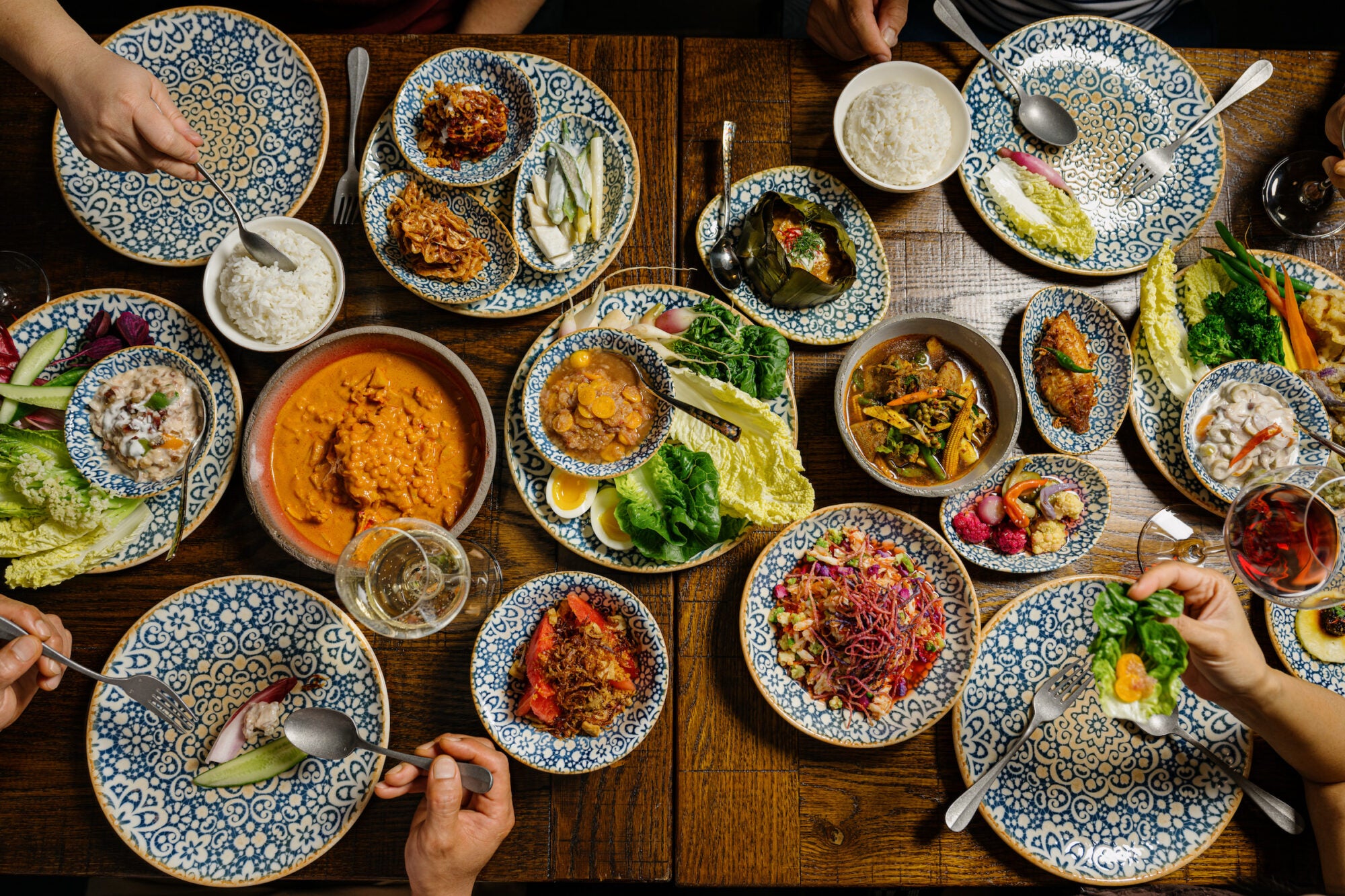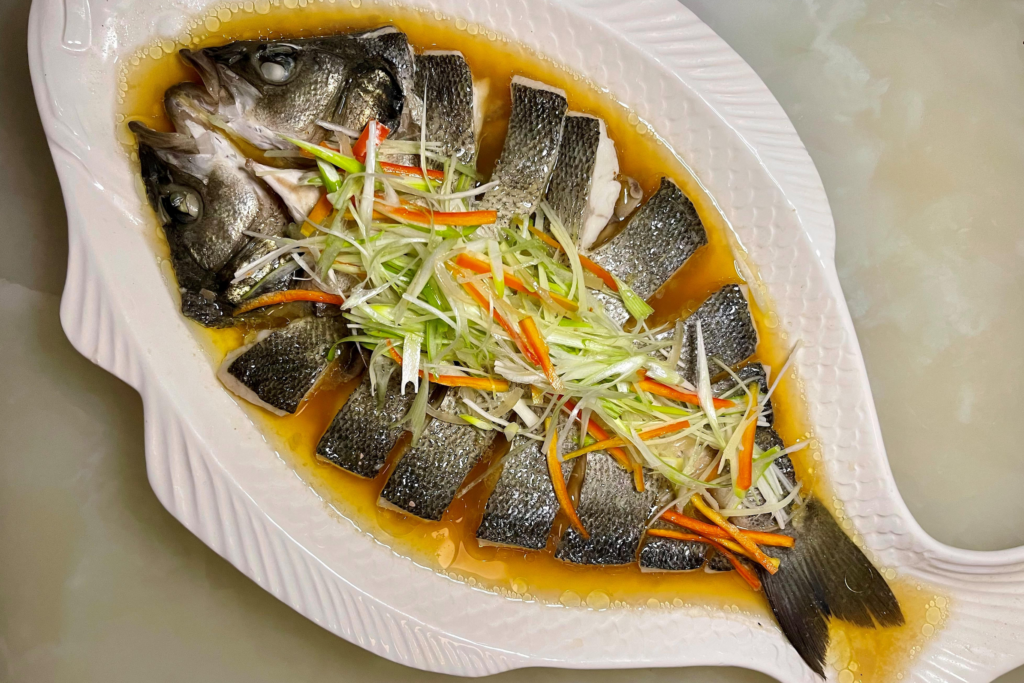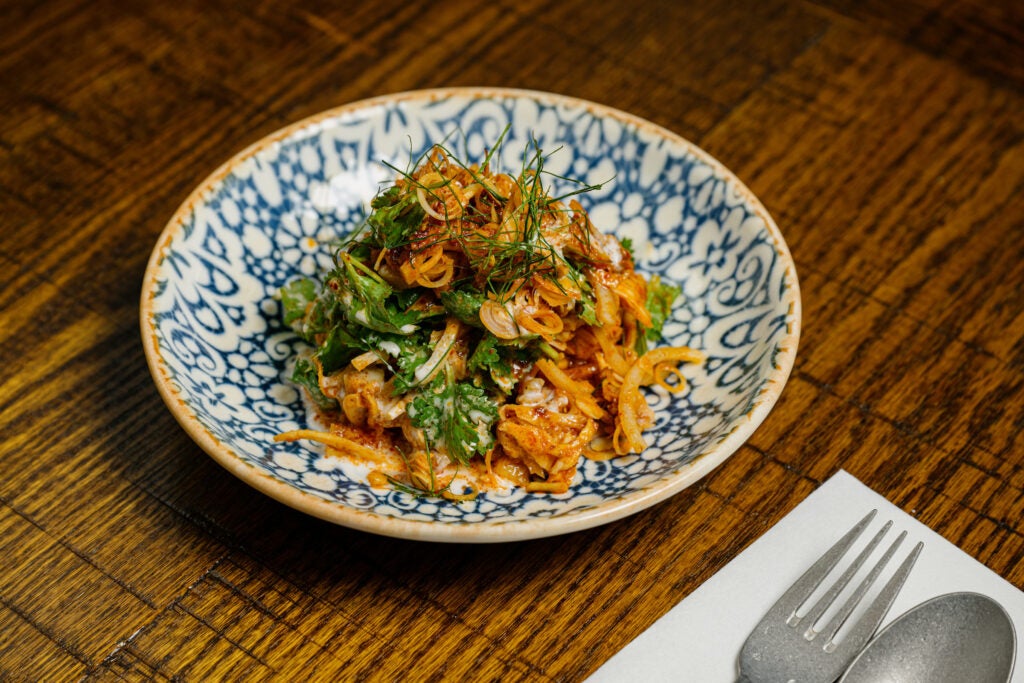
A new generation of talent—from the Bay Area to New York to Texas—is showcasing how Thai cuisine’s constant evolution is true authenticity.
The five-spice pig ear terrine arrives as a bright, almost glowing plate with discs of beet and sunset-hued mango nestled beside thin slices of meat. Chef Ohm Suansilphong dresses the dish with a “complex, ancient peanut sauce” fortified with nine ingredients including pickled plum and Worcestershire sauce. This is the kind of exemplary, border-breaking cooking served at Suansilphong’s Brooklyn restaurant as well as at a host of other restaurants dedicated to a singular pursuit: putting out whatever kind of Thai food they want.
Something is happening among the uppermost caliber of Thai restaurants in the United States. Naruephon “Billie” Wannajaro’s San Francisco restaurant Hed 11 has been celebrated by Michelin for its 11-course dinners; it’s just a 20-minute drive away from Khao Tiew and across the bridge from Berkeley’s Thai breakfast destination Tanzie’s, the San Francisco Standard heralding a “Thai food renaissance” brewing. Last year, chef Earl Ninsom’s titan Langbaan in Portland, Oregon, won a James Beard Award for outstanding restaurant, one of many accolades it has received since opening in 2014. And Phoenix’s Lom Wong has captivated diners since debuting in 2023 to high praise.
Fine-dining Thai restaurants are not new. The San Francisco–based Michelin-starred Kin Khao celebrated its tenth year in 2024, and its ninth holding the coveted star. As Octavia Butler wrote, “There’s nothing new under the sun. But there are new suns.”
In the galaxy of Thai cuisine, a new generation of chefs and restaurants are these new suns. They’re pushing the conversation—and the cuisine—forward instead of treating food like a time capsule. Across the board, this new class of chefs credits their own international travel as inspiration, tapping into their personal understanding of Thai cuisine and chronicling Thai America anew in the process.
Both Thai cuisine as a genre and Thai Americans as a population ballooned in the late 20th century. JoAnn LoSavio, assistant professor of history at Washington State University Vancouver, has explored Thai history before the Hart-Celler Act, also known as the Immigration and Nationality Act of 1965. At that time, LoSavio writes, Thai immigrants in the United States were “privileged, and they came for academic reasons, with the intention to return home.” That is, Thai émigrés were pursuing scholarship, not trying to open restaurants. Their foray into the food business would come in the second half of the century, thanks to US military personnel in the 1960s being stationed overseas and encountering Thai cooking, kicking off an American “fascination with Thai cuisine.”

A very beautiful steamed fish with pickled lime, scallion, shiitake, and soy sauce at KRU.
This was all long before Thailand itself got behind its cuisine’s international popularity, kicking off the Global Thai initiative in 2002 to generate tourism and food exports. Food Republic reports that the Thai government funded thousands of new restaurants around the world by offering millions of dollars in loans for Thai nationals to open restaurants abroad. This program launched alongside the Ministry of Commerce’s “Thai Select” label, a stamp of approval for restaurants and food products that passed muster. Springing from pad Thai’s staying power, restaurants with or without the label tended to prepare recipes from one of the four to six generally recognized regions in Thailand. But things are changing.
Suansilphong looks back much further than the 20th century in his kitchen at KRU, and he only cares so much for regionality. He opened his Brooklyn restaurant in 2024 after his Manhattan Thai hit, Fish Cheeks, opened to great acclaim in 2016. Suansilphong relies on a collection of more than 500 ancient recipe books, tomes he turns to for inspiration and instruction. These writings, held in his personal and expansive library, are not traditional cookbooks, which often came from upper-class or royal chefs. Rather, many were prepared by families as part of funeral ceremonies. He points out that even 800 years ago, those elders encouraged the use of local produce rather than adhering closely to tradition.
That means instead of importing Thai mackerel, otherwise known as short mackerel, he uses Spanish mackerel when it runs through the northeastern United States in the spring and summer, cycling it off the menu when the migration ends. Salted green crab, for instance, tastes just as it was described in those fabled recipes, but it’s paired with a fundamentally different sauce. The restaurant eschews the traditional galangal, lemongrass, and shallots in lieu of a blending and straining technique, incorporating white wine in the fermentation process. The result invokes the food’s origins but moves diners closer toward Suansilphong’s own idea of how the crab should taste.
“[Thailand] has been doing fusion food forever,” Suansilphong says of his approach to cooking. He loves that freedom. A wide array of influences is, to him, honest Thai cooking. The Painters understand that sentiment completely.
Chef Benchawan “G” Jabthong Painter and sommelier Graham Painter are the couple behind Street to Kitchen. Their Houston restaurant is focused on “unapologetically authentic Thai food,” like laab tartare. It’s a traditional Northern Central Thai dish, but here G serves it by gilding the dish with tiny flowers, greens, and an egg yolk. They’ve learned to remix tradition and apply a precolonial American lens to Thailand’s historic cuisines by working with Texas Choctaw natives like chef David Skinner, with whom they co-own the Kemah, Texas, restaurant . For this power couple, that looks a little like KRU’s work: winding back the clock and going beyond convention. They are empowered to fashion whatever mind-blowing, true-to-them meal comes to mind.
G stresses the importance of this freedom, as it’s fair to say that Thai chefs, like many immigrant chefs, are often put into boxes. When she wanted to open her restaurant, she told Graham that American Thai restaurants were “pedantic,” uncreative, inflexible. They decided to leave dogma at home for their venture. No single region to focus on, and no subpar ingredients used to maintain nostalgic tastes. This means skipping a crappy rendition of a standby dish even if it irks expectant diners.

KRU’s herbaceous jackfruit salad.
And it’s turning heads: the James Beard Foundation and Michelin have applauded the pair for reimagining the Thai canon. “Why is the food in Chiang Mai different than in Surat Thani?” Graham says. “It’s culture and history, yeah yeah yeah. But really it’s because of what’s fresh and local around the people cooking.”
That sense of imagination goes double for the Bay Area–based chef Intu-on Kornnawong. Breaking the mold of Thai food is the bedrock of her approach. She made Jo’s Modern Thai a smash hit in Oakland before departing in 2024 to run her own eponymous pop-up highlighting Northeastern Thailand’s , which originated near Laos with a profile of funky, spicy flavors like fried edamame with peanut, reminiscent of tua tod Thai cookies. “I see a new generation doing something cool,” Kornnawong says. “And it’s not Thai American food like we’ve had for a long time.”
Kornnawong points to San Francisco’s Kin Khao specifically, saying chef Pim Techamuanvivit’s recipes set a new bar for restaurants since opening more than a decade ago. She likes that. But she likes this new class of restaurants even more. She wants to eat what she and her friends would be eating back home, like steak over fried rice.
Staying tapped into the evolution of food within Thailand today is paramount to these success stories. The four-person team behind KRU heads to Thailand to see family and travel around the country each January for eating and research. These research trips inform house-made fermentations and sauces, including a play on the Southern Thai “red fermented fish,” or pla paeng daeng, high on KRU’s priority list for 2025. Kornnawong is headed on a trip home and to Japan for a month this winter too. Wannajaro brought over chef Piriya “Saint” Boonprasan from Bangkok just to open Hed 11. And the Painters hit Thailand every year, dining at world-renowned spots like Le Du and Sri Trat.
Chinese cuisine is also a huge part of Thailand’s culinary origins. This is credited to the rich history of Chinese migration to Thailand starting in the 13th century. The country is home to the largest Chinese community overseas, making up between 11% and 14% of Thailand’s population. Crispy pork belly, a Thai favorite in dishes like curry rice balls, comes from China, as does the stir-fry technique used in pad Thai, which literally translates to “Thai stir-fry.” Some influences come from even farther: those infamous chiles, for example, come from Mexico.
Leaving the old Americanized standards to the side does mean that sometimes salty customers are frustrated after asking for pad Thai or dumplings. Portland’s Eem, another of this unbridled cadre that is also owned by Langbaan’s Earl Ninsom, spits in the face of a one-star Yelp review by listing it alongside positive press on its website: “They don’t have pad Thai or chopsticks 🙁 sorry.” It’s thought that Thailand’s most famous dish was a 1930s government invention; the BBC called heading to Thailand for pad Thai “the culinary equivalent of wearing a Nickelback concert T-shirt.” And while chopsticks came to the country thanks to Chinese migrants, ancient Thai people ate with their hands.
But these bold new ideas about Thai food are strong. Long gone are the mere winking riffs on drunken noodles. Now comes the fun stuff: honoring the past, blazing trails into a new future. “Kin Khao are the OGs,” Graham Painter says. “You wanna study the greats, the Dizzy Gillespies and Charlie Parkers. Then you go forward and into the free jazz movement.”